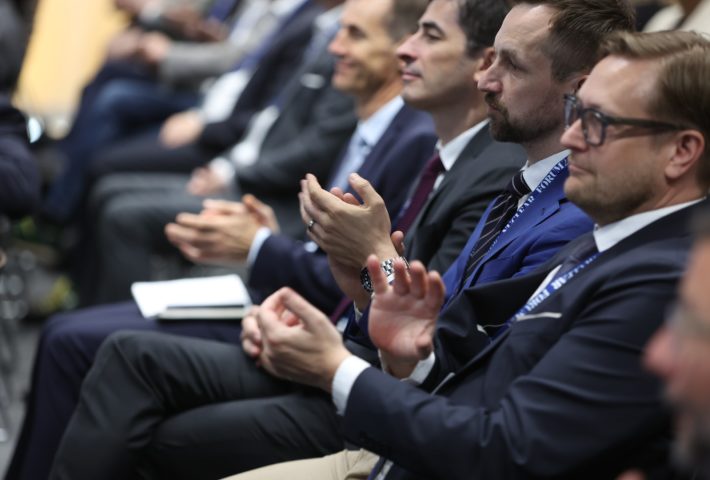
The second day of Nordic Nuclear Forum 2024 was full of insightful speeches and a lot of fruitful networking at the expo area. The theme of the second day was “nuclear technologies and applications” and the different sessions dived into topics like paradigm shift of nuclear industry, research and innovation, competence building and human capacity development. The day kicked off with an inspiring speech from Kai Mykkänen, Minister of Climate and the Environment, Finland. During his speech Mykkänen pointed out that having an increasing amount of clean, emission-free baseload is the most crucial part of trying to aim towards fossil free heating, a growing industry with clean solutions, and at the same time aiming towards carbon neutrality. Mykkänen praised that nuclear energy was the cornerstone of surviving from the energy crisis and the past winter in Finland. This means that while renewable energy is being heavily promoted, nuclear power remains crucial for maintaining grid stability. “It’s not about choosing between; you need both,” he asserted. The current goal is to double or even triple energy production, not merely to replace existing sources. Mykkänen also shared exciting news about the growing popularity of nuclear power in Finland. The country is exploring innovative solutions like Small Modular Reactors (SMRs) to further its energy goals, underscoring Finland’s commitment to a sustainable and reliable energy future.
Here are some highlights from conference day 2:
- Satu Katajala, Director, The World Association of Nuclear Operators (WANO) Paris Centre, declared that a worldwide association for nuclear safety is needed to avoid repeating history’s multiple nuclear accidents. Each incident in history has reinforced the vital lesson that all nuclear power plants are hostages of each other. An incident in one plant will have an enormous effect on all power plants including new builds. Industry’s goals by 2030 is to be safe, reliable and sustainable which WANO will promote by various means. Emphasizing the need to share knowledge and support newcomers, she underscored that “nuclear safety has no borders, so we need to work together.”
- Poland is one of the countries planning to build a nuclear power plant in the country. Philippe Bordarier, Chief Nuclear Officer, Polske Elektrownie Jadrowe (PEJ) gave us an insightful presentation about PEJ’s project to get nuclear power in Poland. “We don’t start with nothing but it is a first of a kind project” Bordarier declared. Poland has a small research reactor and radiation measurement expertise. Main goal is that by 2043 there will be six nuclear reactors producing 25% of Polish energy. Preparatory work of the 1st Polish nuclear power plant has already begun and the construction is planned to start by 2033.
- Kalle Heinola, Technical Expert, IAEA presented the benefits of fusion energy, stating that it is sustainable, reliable, affordable and it could have higher energy gain than conventional reactors. According to Heinola one of these challenges of fusion is the huge amount of heat that it creates. This means that we need to conduct research and find solutions to battle this challenge. The public sector has created a roadmap for this and is currently moving “from lab to track”. In addition, private sector interest towards fusion has increased in past years. They have higher risks than the public sector but they are on a faster track than the public, because their smaller projects are faster in construction.
- In the afternoon the young future energy leaders panel gave an insight from their point of view about the nuclear industry in Finland, Estonia, Norway and Sweden. The panelists emphasized especially the extremely high positive attitude amongst the younger population towards nuclear. They pointed out that the new generation wants to see and be a part of the change but they also need to see some excitement as a bait. They emphasized that making the industry welcoming for the younger generation is crucial. The more the industry shows young people, the more they will be interested. According to Anet Marii Paumets, Coordinator at Fermi Energia and Kaitlyn Bullock, a student at KTH Royal Institute of Technology, the interest is really high in Sweden and Estonia. Some Estonian students even go abroad to study the field. But in Norway and Finland the situation is a bit more difficult. According to Edvin Edvardsen, Senior Adviser, Project coordinator, IFE in Norway there are a large number of decommissioning which doesn’t make it easy to convince the youth that nuclear is not a dead-end job. From Finland’s point of view Markus Manninen, a student at Aalto University stated that the limited number of trainee-positions discourages many people away from the field. When asked about how to motivate younger people into choosing nuclear they all emphasized that new innovations and change is a good motivator, because it keeps the job interesting. It is also important to give freedom for people to explore and be flexible within the workplace.
- On the important topic of long term operation and aging management of NPPs, we learned about the updates from perspectives of utilities, authority, suppliers and EPRI. Several speakers of this topic defined why we need LTO: for energy security and diversity, reliability and to become carbon free. Johan Börjesson, Deputy Managing Director Forsmark Nuclear Power Plant, Vattenfall, stated that majority nuclear plants aim for extension beyond 60 years and according to a feasibility study lifetime of 80 years is possible. Daniel Wells, Director, EPRI saw it positive that in Finland nuclear power plant can be in use as long as it is safe to use and you can prove it, regarding the designed life-time.
- Nordic Nuclear Forum 2024 ended with a speech from Riku Huttunen, Director General, Ministry of Economic Affairs and Employment. He acknowledged the current industry challenges impacting everyone. However, he highlighted reasons for optimism. Increasing global climate goals emphasize the need for clean energy, and advancements in modular technologies offer promising solutions. Achieving success requires a focus on investments, safety, quality, and faster project timelines. Cost-effective reactor designs like Small Modular Reactors (SMRs) and international collaboration in permitting processes were identified as key factors. Huttunen recognized the need for flexibility, emphasizing that a “one-size-fits-all” approach to legislation won’t work. Through innovation, collaboration, and a commitment to attracting future talent, the nuclear industry is building the foundation for a brighter, cleaner energy future.
All good must come to an end at some point and now it is our time to thank everyone. Thank you to our Sponsors, Partners, all of the Exhibitors and amazing Speakers who created the vibrant atmosphere in Pikku Finlandia. Special thanks to all of the participants for joining, we hope that you found the event valuable and enjoyed your time in Pikku Finlandia, until next time!
Author Sonja Kaitosaari
Picture by Mikael Leppäniemi




